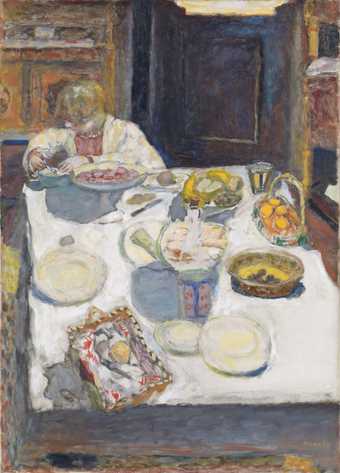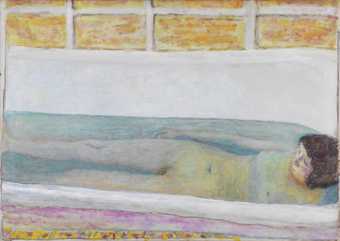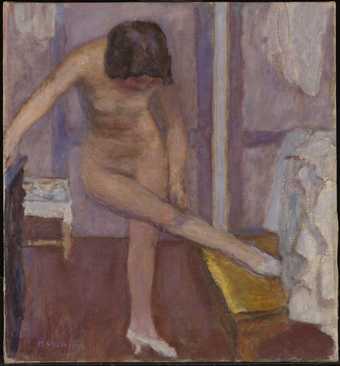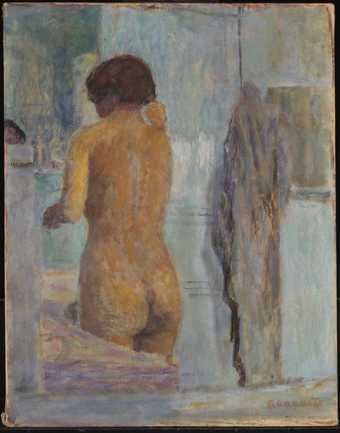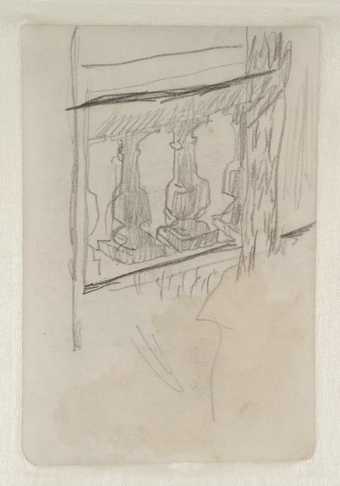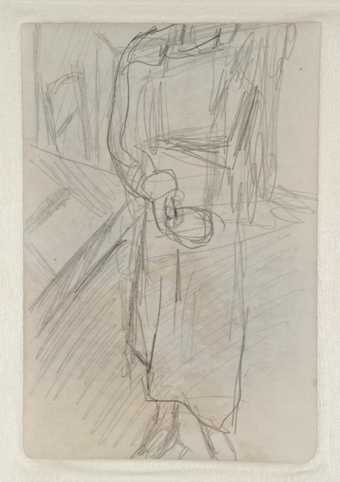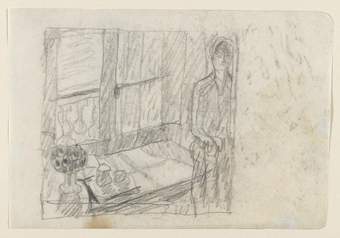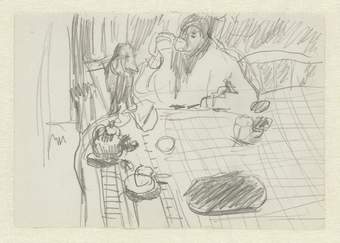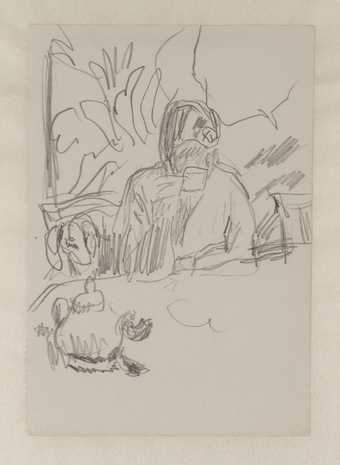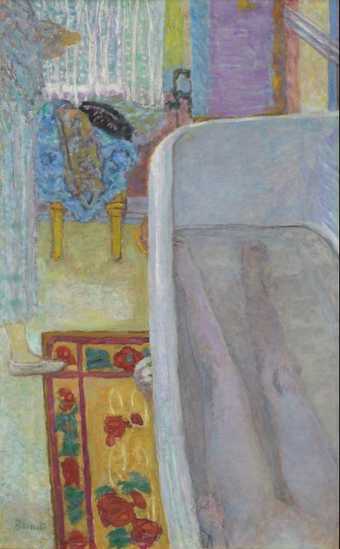
- Artist
- Pierre Bonnard 1867–1947
- Original title
- Le Café
- Medium
- Oil paint on canvas
- Dimensions
- Support: 730 × 1064 mm
frame: 948 × 1282 × 95 mm - Collection
- Tate
- Acquisition
- Presented by Sir Michael Sadler through the Art Fund 1941
- Reference
- N05414
Summary
Coffee 1915 (Tate N05414) is a large oil painting on canvas by the French artist Pierre Bonnard. Three pencil sketches on paper relating to the work, all entitled Preparatory Sketch for ‘Coffee’ and each made in 1915, are also in Tate’s collection (Tate T06545, T06546, T06547). In the painting, a table is shown from the front and at a slightly elevated angle. It is covered in a bright red and white checked tablecloth on which a coffee pot, two white cups and a serving platter for food have been placed. The table is only partially shown and extends into the foreground to meet the canvas’s lower edge. A woman dressed in vivid yellow sits at the far side of the table, sipping a cup of coffee and turning towards a small dog, who is standing on the edge of the chair with two paws on the table. The torso and arm of a second woman, dressed in blue, is seen reaching down towards a glass on the table, and it is unclear whether she is entering or leaving the room. The composition is framed at the right by a yellow, red and blue decorative border running down the side of the painting; this is echoed by a similar band of colour on the wall behind the dog. A wall hanging or painting appears in the background. The palette is restricted almost entirely to red, yellow, blue, white and brown, and the black serving platter contrasts strikingly with the vibrant tablecloth, providing a solid form on which to focus. Some objects, such as the chair to the left, cast strong shadows in vivid colours. The atmosphere is one of quiet domesticity and the viewer is positioned as if about to join the woman.
The three sketches, all executed rapidly, show elements of the composition in progress. T06547 is the least resolved, with a loose rendering of the heads and upper bodies of the dog and seated woman. T06546 depicts the seated woman sipping coffee, a coffee pot on the table and a decorative background, as well as the dog, which in this version is seated. T06545 concentrates on refining the movement of the central figure: she holds her coffee cup aloft, caught in the act of drinking; the tablecloth has appeared and the dog stands, front paws balancing on the table, on which most of the objects featured in the painting have been sketched.
Bonnard created these images in 1915, most likely a house he rented in Saint-Germain-en-Laye, Paris. In the case of Coffee, which has also been known as Afternoon Tea, oil paint has been loosely and vigorously applied to the canvas and there is evidence of colours bleeding into each other, most notably the red and white of the tablecloth. Bonnard has selected intense pigments including vermilion, cadmium and strontium yellows, cadmium orange, cobalt blue, Prussian blue and natural ultramarine. The painting is signed in the lower right corner. There is evidence of alterations in the work, and art historian Timothy Hyman has noted that the composition has been significantly extended along the lower edge and that the chair on the right has been moved towards the centre, with the standing woman painted over it and extended (Timothy Hyman, Bonnard, London 1998, p.92). The sketches also provide evidence of Bonnard’s reworking, in particular the placement of the seated woman and the dog. Her position changes markedly from a relaxed intimacy with her pet in T06547, to sitting alongside it in T06546, to twisting towards it in T06545. The sketches are uniform in size and it is likely that they initially formed part of a sketchbook.
The subject of focus in the painting and sketches is Bonnard’s wife, Marthe. The artist’s domestic life was a major focus for his work. Art historian Nicholas Watkins has described how domestic settings allowed Bonnard to record the ‘atmosphere, incidents and relationships that caught his eye’ (Watkins 2002, p.56). A large part of the composition of Coffee, and that of sketches T06545 and T06546, is taken up by the table. The critic Richard Cork has emphasised the importance of Marthe’s positioning at the end of the table: ‘you get the very strong feeling the artist is sitting at the table himself. Although he looks down on the scene from a slightly aerial viewpoint, he’s very close to, almost as though he’s participating in the drinking or eating’ (Richard Cork, ‘Audio Transcript: Pierre Bonnard’s Coffee’, no date, http://www.tate.org.uk/art/artworks/bonnard-coffee-n05414/text-audio-transcript, accessed 20 May 2016). Cork has also suggested that in Coffee, which was painted during the First World War, Bonnard ‘hid himself away from what else was happening in the world and concentrated on everything that was around him’ (Cork, no date, accessed 20 May 2016). Watkins has stated that Bonnard’s ‘little drawings, quickly sketched in a pad secreted in his hand, assumed an extremely important function in his art; they represented his codified sensations of specific experiences and served as the starting point for paintings executed in the studio’ (Watkins 2002, p.134). Bonnard himself stated that for him ‘drawing is sensation. Colour is reasoning’, arguably a reversal of traditional definitions of these two elements of mark-making (quoted in Watkins 2002, p.134).
In 1944 Bonnard stated: ‘I float between intimism and decoration, one does not reformulate oneself’ (quoted in Watkins 2002, p.59). His interest in painting as decoration can be traced to the influence of his contemporary Henri Matisse as well as his early association with the post-impressionist movement Les Nabis, including his close associate Edouard Vuillard. This is also evident in the fleeting, transforming power of light captured in Coffee and its emphasis on colour as a means of defining form.
Further reading
Sarah Whitfield and John Elderfield, Bonnard, exhibition catalogue, Tate Gallery, London 1998, reproduced p.111.
Nicholas Watkins, Bonnard, London 2002.
Fiona Hesse (ed.), Pierre Bonnard, exhibition catalogue, Fondation Beyeler, Basel 2012, reproduced front cover.
Jo Kear
May 2016
Supported by Christie’s.
Does this text contain inaccurate information or language that you feel we should improve or change? We would like to hear from you.
Display caption
The dining table was one of Bonnard’s favourite subjects. Its associations with domestic routine and conviviality were in tune with his intimate vision of art. Here, the artist’s wife Marthe sips coffee, with her pet dog at her side. The table stretches invitingly before us, so that the painting appears to record the casual glance of someone about to sit down opposite Marthe. As can be seen in the preparatory sketches shown alongside the painting here, Bonnard’s composition was carefully planned and developed.
Gallery label, October 2016
Does this text contain inaccurate information or language that you feel we should improve or change? We would like to hear from you.
Catalogue entry
N05414 Le Caf? (Coffee) 1915
Inscribed 'Bonnard' b.r.
Oil on canvas, 28 3/8 x 41 7/8 (73 x 106.5)
Presented by Sir Michael Sadler through the NACF 1941
Prov: With Josse Hessel, Paris; with Bernheim-Jeune, Paris, 1923; with Independent Gallery, London, 1924; Sir Michael Sadler, Oxford
Exh: The CAS: Second Loan Exhibition of Foreign Paintings, M. Knoedler, London, February 1928 (40); The Tate Gallery's Wartime Acquisitions (2nd Exhibition), CEMA touring exhibition, November 1944-November 1945 (7, repr.); The Tate Gallery's Wartime Acquisitions (2nd Exhibition), National Gallery, London, June-July 1945 (4, repr.); Paintings by Pierre Bonnard and Edouard Vuillard, RSA, Edinburgh, August-September 1948 (43); Pierre Bonnard, RA, London, January-March 1966 (120); Pierre Bonnard, Haus der Kunst, Munich, October 1966-January 1967 (69, repr.); Pierre Bonnard, Orangerie des Tuileries, Paris, January-April 1967 (79, repr.)
Lit: Jean and Henry Dauberville, Bonnard (Paris 1968), No.822, Vol.2, p.351, repr. and dated 1915
Repr: Formes, No.9, November 1930, between pp.4 and 5; Studio, CXXVII, 1944, p.151
The girl on the left (Marthe Bonnard) appears again wearing the same dress and holding what looks like the same dog in a painting in the Mus?e de Grenoble, 'Young Woman with a Dog', which is signed and dated 1914.
This picture has also been known as 'Afternoon Tea'.
Published in:
Ronald Alley, Catalogue of the Tate Gallery's Collection of Modern Art other than Works by British Artists, Tate Gallery and Sotheby Parke-Bernet, London 1981, pp.64-5, reproduced p.64
Explore
- interiors(2,776)
-
- domestic(1,795)
-
- dining room(64)
- food and drink(980)
-
- drink, coffee(24)
- table(754)
- table cloth(51)
- coffee pot(18)
- cup / mug(154)
- actions: postures and motions(9,111)
-
- sitting(3,347)
- woman(9,110)
- individuals: female(1,698)
- France(3,508)
You might like
-
Pierre Bonnard The Table
1925 -
Pierre Bonnard The Window
1925 -
Pierre Bonnard The Bath
1925 -
Pierre Bonnard Pont de la Concorde
1913–15 -
Pierre Bonnard The Bowl of Milk
c.1919 -
Pierre Bonnard Nude Bending Down
1923 -
Pierre Bonnard Bathing Woman, Seen from the Back
c.1919 -
Pierre Bonnard Preparatory Sketch for ‘The Bowl of Milk’
c.1919 -
Pierre Bonnard Preparatory Sketch for ‘The Bowl of Milk’
c.1919 -
Pierre Bonnard Preparatory Sketch for ‘The Bowl of Milk’
c.1919 -
Pierre Bonnard Preparatory Sketch for ‘The Bowl of Milk’
c.1919 -
Pierre Bonnard Preparatory Sketch for ‘Coffee’
1915 -
Pierre Bonnard Preparatory Sketch for ‘Coffee’
1915 -
Pierre Bonnard Nude in the Bath
1925 -
Pierre Bonnard The Yellow Boat
c.1936–8

